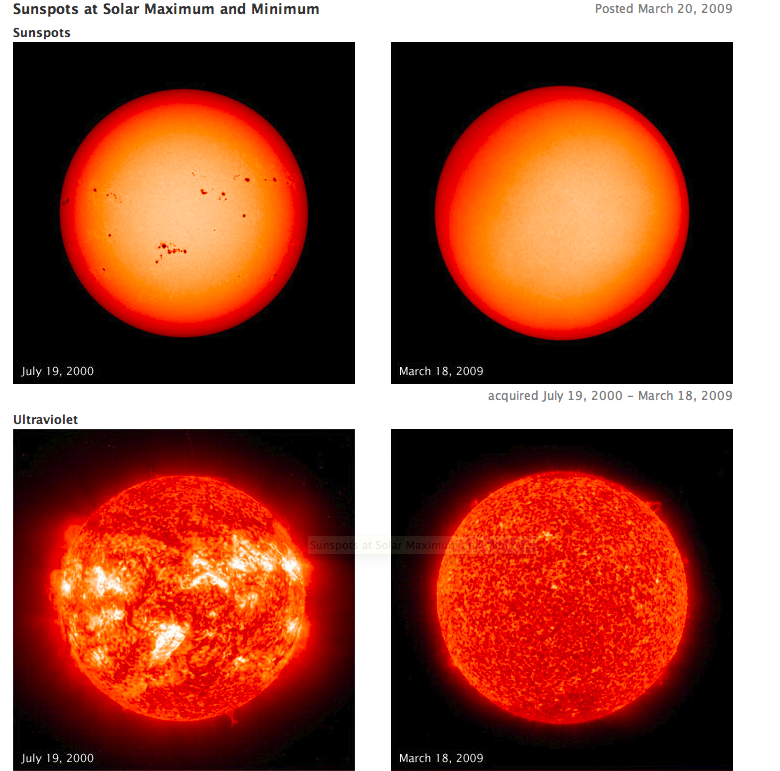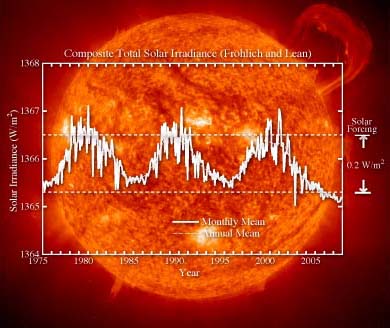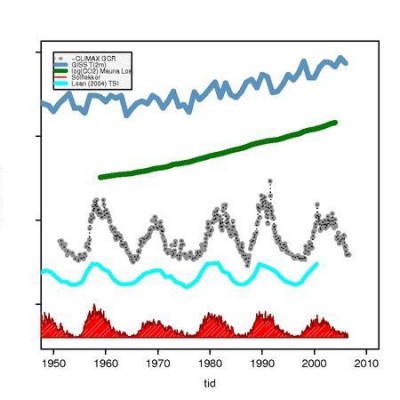25 March 2009
The Case of The Missing Sun Spots
Posted by Dan Satterfield
Do sun spots control Earth’s climate?
YES!
So does El Nino, La Nina, and the myriad of other oceanic oscillations. So do the slow regular changes in our orbit around the sun, and so do the ever increasing amount of greenhouse gases, in our atmosphere.
The affect of the sun spot cycle on our climate has been investigated quite well. Thanks to bogus claims that the warming of the 20th century was due to sun spots, and cosmic rays, this has actually been investigated to a greater degree, than would normally be the case.
Now, don’t go telling everybody, but the sun is late. Nothing to panic about yet, but our normally active sun has gone very quiet.
 Above image courtesy NASA
Above image courtesy NASA
The sun goes through an 11 year sunspot cycle (It actually takes the sun 22 years to complete one cycle, but this cycle includes two sun spot maxima.) Amateur radio operators are quite familiar with this cycle, as it affects radio transmissions. NASA keeps an eye on it as well, because when the sun spot cycle is peaking, there can be large solar flares that can affect Astronauts and satellites.
In between one of the moon landing missions, there was a gigantic flare that could have been fatal for moon walking astronauts. NASA had a contingency for this. One Astronaut would lie on top of the other on the moon. The water in his body would block the radiation, and the guy on the bottom would escape a fatal dose. The Astronaut on top would not be so lucky.
There are a lot of cross polar flights now, and the airlines have to monitor the sun closely. A large flare will knock out high frequency radio, and the FAA demands constant contact with commercial aircraft. Passengers would also get a dose of radiation crossing the pole during a flare. It would not be serious, but the air crews on the flights, could end up with multiple doses if this was not watched.
So it is watched!
NOAA now has a Space Weather Center at the Earth Systems Research Lab. in Boulder,Colorado. I visited it last June.
The solar cycle reached it’s bottom late last year, and the sunspots should be starting to increase again now.
Except they aren’t!
At first thought, one might expect the sun to be cooler, with a bunch of dark spots on it’s surface, but the opposite is true. The sun puts out a bit more energy when there are a lot of spots, especially in the ultraviolet. This solar cycle does affect planetary temps. The planet cools slightly when sun spots are low, and warms a little when the sun is active. Feed-backs, caused by Ozone in the stratosphere, magnify it slightly as well.
Slightly. The change in solar radiation at our distance from the sun is from 1365 Watts/M(sq) to 1367 W/M(sq). This equates to about 0.1 deg. C of change. Not much. In contrast, the Earth’s temperature varies back and forth, about .3-.5C , because of all the factors I mentioned above. The current La Nina, acts to cool the planet somewhat. (In spite of that, the February temperature of Earth was the 10th warmest on record).

While the sun has been in it’s quiet phase for an unusally long time, it is nowhere near a record. It was quieter longer in the frst part of the 1900’s. It also seems that indeed the sun has been fairly active over the last 50 years compared to the past several hundred. So we may indeed be going back to a quieter sun. This will undoubtedly bring out those claiming that the warming of the past 50 years, was all the sun’s doing. Read the paragraph above!
Better yet look at the image below. The bottom 3 graphs are the sun. The Blue curve at top is temperature. The green curve is the Carbon dioxide levels from Mauna Loa.

In the late 1600’s and into the 1700’s, there was an almost complete lack of sunspots for several decades! It is called the Maunder Minimum. The planet did indeed cool, although part of that was likely due to volcanic activity. Volcanoes have been very well documented to cause much greater fluctuations on Earth’s temp. than the solar cycle.
If we were to go into a new extended period of low sunspot activity, would this wipe out the affects of the increasing carbon dioxide in the atmosphere?? For that answer, we have Dr. James Hansen (NASA’s top Climate Scientist). He ran the numbers.
At the rate of CO2 increase (Around 2 parts per million per year) the cooling from a sun in long term quiet phase, would be wiped out in just 7 years.
Soon there will be gaggle of internet Climate experts claiming that the sun has gone quiet ,and we will cool back down now. It was all the sun’s doing! Told ya so!
This kind of thing reminds me of a true story about W.C. Fields. As he lay dying in a California hospital, a friend walked into his room. She was surprised to see the firmly agnostic comedian reading the Bible. “What are you doing??” she asked.
W.C. Fields replied- “Looking, — for loopholes“.
Later,
Dan
Thanks to NASA Earth Observatory/James Hansen NASA GISS for the info/data.


 Dan Satterfield has worked as an on air meteorologist for 32 years in Oklahoma, Florida and Alabama. Forecasting weather is Dan's job, but all of Earth Science is his passion. This journal is where Dan writes about things he has too little time for on air. Dan blogs about peer-reviewed Earth science for Junior High level audiences and up.
Dan Satterfield has worked as an on air meteorologist for 32 years in Oklahoma, Florida and Alabama. Forecasting weather is Dan's job, but all of Earth Science is his passion. This journal is where Dan writes about things he has too little time for on air. Dan blogs about peer-reviewed Earth science for Junior High level audiences and up.
Another interesting weather/climate area where sun spot acitivty is being used to forecast is tropical cyclone activity. Last year a paper was published by J.B. Elsner and T.H. Jagger discussing the potential connection between tropical cyclones in the North Atlantic basin and solar activity (http://myweb.fsu.edu/jelsner/PDF/Research/ElsnerJagger2008.pdf). Recently I discovered that there is a group in Houston, TX called Weather Research Center that uses sun spot activity as a basis for their seasonal tropical cyclone forecasts. They are calling for only 7 named storms this year, which is less than the current climatology numbers of 10-11 and also significantly less than projections from other groups that do this type of forecast. Their forecast for this year can be found here – http://myweb.fsu.edu/jelsner/PDF/Research/ElsnerJagger2008.pdf. It will be interesting to see if it pans out.
Fascinating! It will be interesting to see. Somewhere there is a paper about the NAO and solar cycle. Have not been able to find it.@MJ:
The style of writing is quite familiar . Have you written guest posts for other blogs?
Hi I discovered this webpage by mistake, I was flipping through Bing when I found your website, I must say your website is really great I truely think the content, its amazing!. I don’t have the time in this instance to fully read your blog but I have favorited it and also subscribed for your RSS feeds. I will be back in a day or two. Thanks for a great blog.